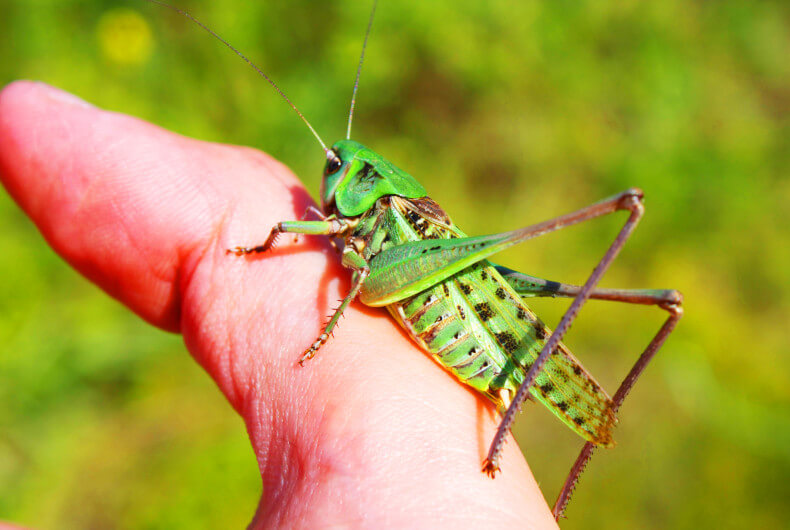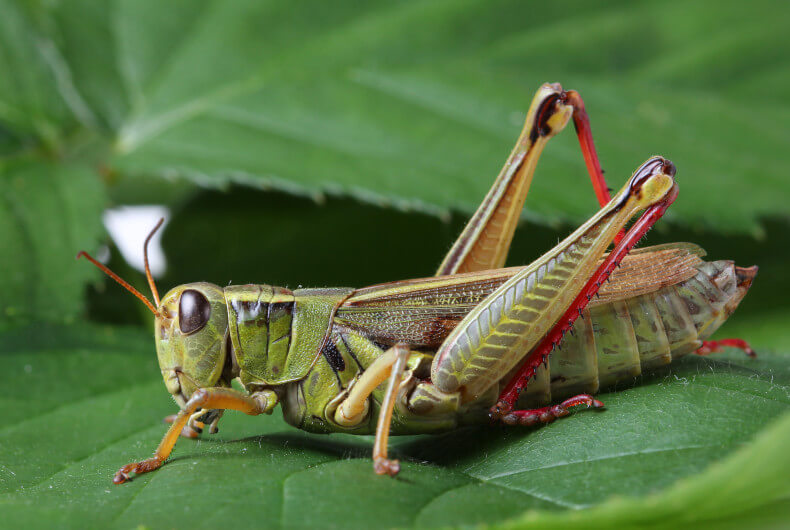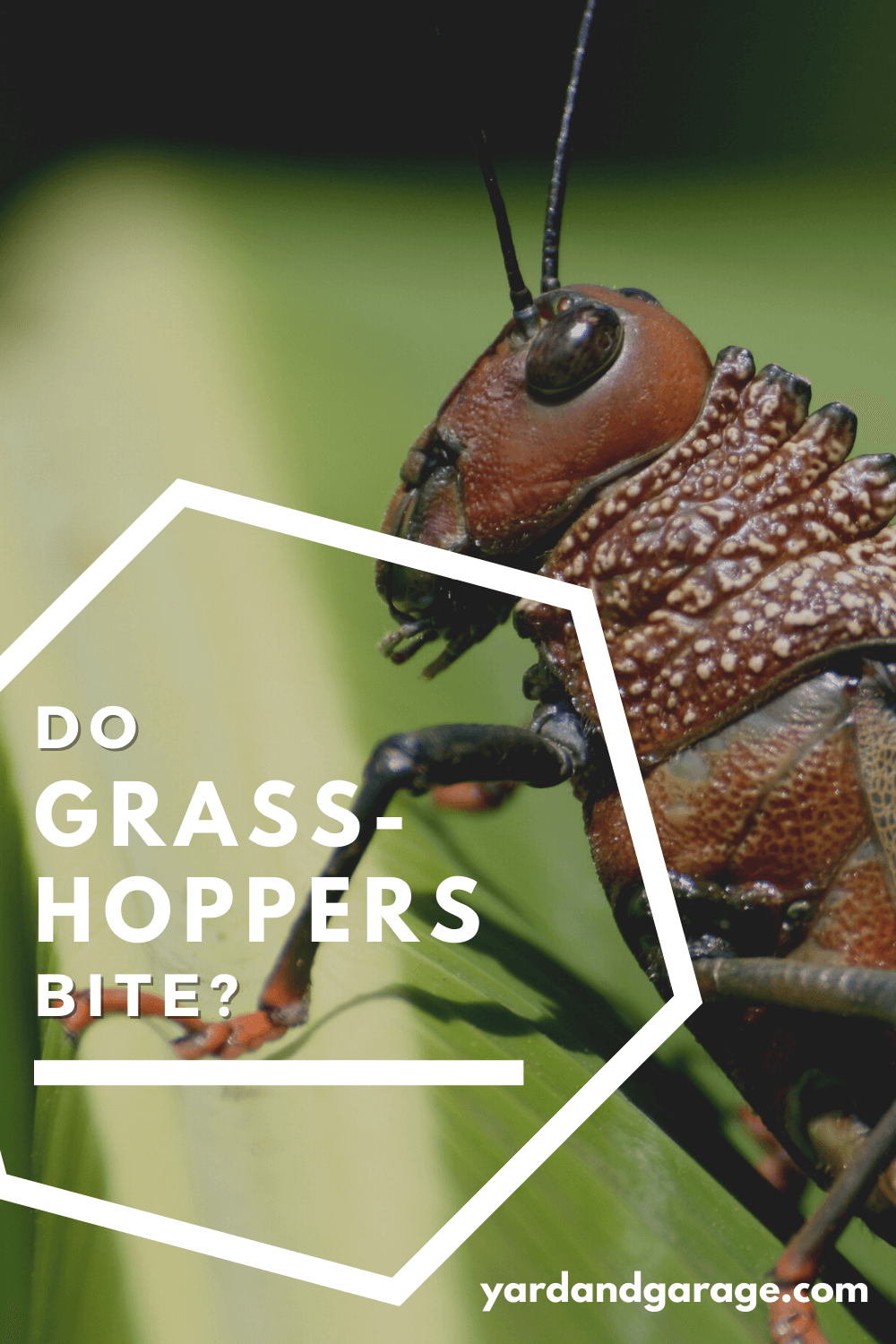 Nothing beats a lovely afternoon in the backyard with your family. You can throw a picnic and soak in the rays as you enjoy some much-needed fresh air.
Nothing beats a lovely afternoon in the backyard with your family. You can throw a picnic and soak in the rays as you enjoy some much-needed fresh air.
However, it can be difficult to relax when bugs are hopping around all over the place. You’re likely to encounter many insects in the great outdoors, but grasshoppers are probably the most common bug that you’ll run into.
They don’t have the most flattering appearance, so it’s easy to feel unnerved in their presence. Naturally, when faced with a strange bug that moves in unpredictable ways, you might be worried about bites or stings.
You care about your family and don’t want to put them in harm’s way, so check out this comprehensive overview of grasshoppers and their bites before your next outing.
Table of Contents
Grasshoppers Explained
Grasshoppers are small bugs belonging to the suborder Caelifera. There are over 10,000 species of grasshopper, and they can be found across the globe.
Different grasshopper species come in different sizes, and some can grow up to three inches long.
Grasshoppers are notable for jumping several feet in the air, and most species can fly short distances with their wings.
While most grasshoppers are solitary creatures, some species may develop into locusts and form swarms in drought conditions.
Locust swarms migrate across vast distances in search of food, and they eat more than ordinary grasshoppers. While all locusts are grasshoppers, not all grasshoppers are locusts.
Certain kinds of grasshoppers can only become locusts after droughts and under other environmental conditions. Most individuals of these species never develop into locusts during their lifetimes.
What Do Grasshoppers Eat?
Grasshoppers are usually herbivores. They will eat almost any kind of plant and enjoy many parts of a plant.
They’ll eat leaves, stems, flowers, berries, and everything in between. However, when there’s not enough vegetation to go around, grasshoppers will happily eat mushrooms, moss, carrion, dung, or other insects.
At their best, grasshoppers are a mild annoyance. At their worst, they may come as a locust swarm, annihilating crops and leading to food shortages.
Do Grasshoppers Bite or Sting?
Thankfully, grasshoppers lack stingers, so they do not sting.
They can, however, bite people. This is because grasshoppers have mandibles like ants and many other insects.
They use their mandibles to rip leaves, flowers, and other vegetation apart so that they can more easily digest it.
Are Grasshoppers Even Able To Bite People?
While a grasshopper can bite a person, a bite from a grasshopper won’t break the skin. Human skin is much thicker than leaves and stems, so a grasshopper’s mandibles aren’t strong enough to make you bleed.
Thus, while receiving a bite from a grasshopper may be unpleasant, it’s not a very big deal.
Why Would a Grasshopper Bite a Person?
There are several reasons why a grasshopper may bite a person. The most common grasshopper bites come from locusts. Locusts are put into a manic state by the environmental triggers that cause them to become locusts in the first place.
This manic state is intended to make them consume as much food as possible. Consequently, locusts sometimes mistake people for food and bite them when swarming in inhabited areas.
However, after the first bite, a locust will realize that a human is not food, so they will fly off searching for something more edible.
Regular grasshoppers are a bit more level-headed, so they are not very likely to mistake you for a flower or vegetable.
However, they may still try to bite you if they feel threatened.
For example, if you catch a grasshopper and keep it trapped in your hands for a while, then there’s a good chance that it will eventually bite your hand.
However, unless you’ve antagonized a grasshopper and left it with no other option but to defend itself, a grasshopper won’t have any reason to bite you.
Does a Grasshopper’s Bite Hurt?
Grasshopper bites aren’t nearly as painful as bites from other insects. Although it may not feel great, a grasshopper bite is more akin to a tiny pinch than a hornet’s sting.
So naturally, children and people with a low tolerance for pain may find a grasshopper bite quite unpleasant.
Since children often like catching bugs for fun, it’s a good idea to warn a child about the risk of antagonizing the grasshoppers in their yard.

Are Grasshoppers Dangerous?
Because a grasshopper’s mandibles can’t pierce the skin or cause you to bleed, a grasshopper bite is no cause for alarm. Sure, it won’t feel too good, but you don’t have to worry about being sent to the hospital by a rowdy gang of grasshoppers.
Locust swarms, on the other hand, come with their own dangers. Because locusts fly around in a severely aroused state, they may fly into your car and cause a big distraction while you’re behind the wheel.
For this reason, you should keep your windows up while locusts are around. Otherwise, you may be too distracted to drive safely.
You also shouldn’t ride a motorcycle while a locust swarm is nearby.
Locust swarms annihilate crops and cause famines in many parts of the world. Millions of people have starved to death after losing their food to locusts.
Are Grasshoppers Poisonous?
Grasshoppers are neither poisonous nor venomous. Thus, a grasshopper bite won’t make you sick, and your pets won’t become dangerously ill after eating a few grasshoppers.
Still, grasshoppers are very high in protein, so you should try to prevent your pets from eating too many of them as they frolic in your yard.
Otherwise, your pets may gain weight or develop kidney issues from consuming too much protein.
Can Grasshoppers Spit?
While grasshoppers do have saliva, they don’t spit as a human would. Instead, when threatened, a grasshopper will regurgitate the contents of its stomach.
The regurgitated material is a brown liquid consisting of digestive acids and plant matter. Although this liquid is somewhat gross, it is not harmful to humans in any way.
You’re most likely to encounter this liquid when handling grasshoppers for long periods. Luckily, grasshoppers only produce a small amount of the stuff, and you can easily wash it off of your hands or clothes.
Are Grasshopper Bites Infectious?
A grasshopper bite can’t pierce your skin, so it is almost impossible for a bite to result in infection.
However, grasshoppers occasionally spend time around dung and other unsanitary things. Therefore, whether a grasshopper bites you or not, it’s a good idea to wash your hands after any physical contact.
What To Do When a Grasshopper Bites You
Inspect the Bite
First and foremost, you should look at the spot where the grasshopper bit you. Did it bite you in multiple places? Most grasshopper bites will look somewhat red, and there may be a minor swelling around the bite.
Although grasshoppers are unlikely to penetrate your skin, you should still look for open wounds.
Disinfect the Bite
Once you’ve identified the bite, it’s time to clean it up. Before anything else, you’ll want to wash your hands and the affected area with soap and water.
If the bite is painful or bleeding, you shouldn’t scrub too hard. After washing up, you should apply rubbing alcohol, hydrogen peroxide, or another safe disinfectant to the affected area.
Patch the Wound and Wait for It To Heal
Once you’ve washed and disinfected the wound, it’s time to put on an adhesive bandage. If you’re especially worried about infection, then you may want to apply a dab of some over-the-counter antibiotic ointment to the dressing.
Your bandage should fully cover the affected area. The wound will likely heal within a couple of days.
In the meantime, you should take care not to get it wet. If the bandage falls off, then you can simply replace it.
How Can You Avoid Grasshoppers in the First Place?
Grasshoppers mainly live in the wilderness. They love fields, forests, and gardens, but they’ll make themselves at home anywhere that has a bit of vegetation.
Thus, you’ll likely encounter them in city parks, near roadsides, and any other place with even a little greenery.
Grasshoppers can climb up the sides of concrete buildings, so you may even encounter one on a balcony on a high floor of an office or apartment building.
Unless you lock yourself inside at all times, you’re bound to encounter a grasshopper at some point. You don’t need to be afraid of grasshoppers. However, if you really detest them, you should at least know what attracts them to avoid those places.
What Attracts Grasshoppers?
Grasshoppers need vegetation and water to survive. However, they aren’t very picky. They’ll eat crops, leaves, stems, blades of grass, and anything in between.
Therefore, you will find them in any place with suitable water and vegetation. You’ll encounter more grasshoppers on a farm than in a city, but they like to hop around almost anywhere.
Grasshoppers like to lay their eggs in dense patches of grass or weeds where people don’t usually walk, so you will likely see a few young grasshoppers in any unattended or rundown areas.
How To Get Rid of Grasshoppers
Because grasshoppers like to lay their eggs in tall grass and thick vegetation, you can easily reduce the number of grasshoppers on your property by regularly mowing your lawn, trimming hedges, and uprooting stray weeds.
Grasshoppers hate the smell of garlic, so you can spray a mixture of garlic juice and water on your plants to keep them away.
Since wild birds love munching on grasshoppers, hanging bird-feeders should drastically reduce the number of grasshoppers on your property.
Commercial pesticides also work on grasshoppers, but many anti-pest products can harm pets, children, and wildlife.
Therefore, you should read the label on any pest control product you find, and you should only use poisons as a last resort. If no method effectively gets grasshoppers away from your property, then you may want to call a professional pest control service. They’ll have all of the tools and experience necessary to make your grasshopper problem disappear.
Frequently Asked Questions About Grasshoppers
Do Grasshoppers Have Teeth?
Grasshoppers do not have teeth. Instead, they have mandibles and maxillae. The mandibles are the big pincers that you can see between the jaws, and they’re used to grab, tear, and chew food.
The maxillae, the tiny arm-like structures next to the mandibles, help a grasshopper manipulate food and bring it deeper into the mouth.
Can Grasshoppers Harm Humans?
While locusts may devastate crops and be a serious annoyance, most grasshoppers are not harmful. A grasshopper may munch on your plants or bite you, but you never have to worry too much about them.
Grasshoppers are easy to get rid of, and a bite won’t leave any significant damage.
What Happens if a Grasshopper Bites You?
Typically, a grasshopper bite will feel like nothing more than a tiny pinch.
If you’ve ever been bitten by an ant or a mosquito, then you have a general sense of what a grasshopper bite might feel like. After a grasshopper bites you, it will probably try to hop away.
The affected area may be slightly red and swollen, and you should sanitize and bandage the area immediately.
—
While nobody wants to be bitten by a grasshopper, a bite won’t ruin your day, and it’s no real cause for concern.



